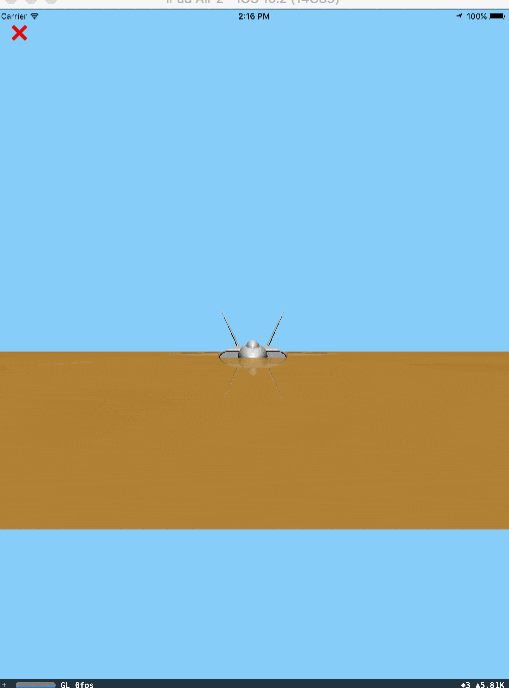我有一架正在飞行的飞机,我正在跟随它,并显示飞机飞行的路径。我使用圆柱体作为路径的线条。这有点像在两个点之间画一条直线。我有一个cameraNode,最初设置为(0,200,200)。在那个点上我可以看到飞机。但是当我开始飞行时,它就飞出了屏幕。我想要做两件事:
 这是我如何设置我的相机:
这是我如何设置我的相机:
这里是我尝试改变相机位置但未成功的代码:
- 只跟随飞机(路径无关)。
- 显示整个路径和飞机。
 这是我如何设置我的相机:
这是我如何设置我的相机:- (void)setUpCamera {
SCNScene *workingScene = [self getWorkingScene];
_cameraNode = [[SCNNode alloc] init];
_cameraNode.camera = [SCNCamera camera];
_cameraNode.camera.zFar = 500;
_cameraNode.position = SCNVector3Make(0, 60, 50);
[workingScene.rootNode addChildNode:_cameraNode];
SCNNode *frontCameraNode = [SCNNode node];
frontCameraNode.position = SCNVector3Make(0, 100, 50);
frontCameraNode.camera = [SCNCamera camera];
frontCameraNode.camera.xFov = 75;
frontCameraNode.camera.zFar = 500;
[_assetActivity addChildNode:frontCameraNode]; //_assetActivity is the aircraft node.
这里是我尝试改变相机位置但未成功的代码:
以下是修改相机位置的代码:
- (void)showRealTimeFlightPath {
DAL3DPoint *point = [self.aircraftLocation convertCooridnateTo3DPoint];
DAL3DPoint *previousPoint = [self.previousAircraftLocation convertCooridnateTo3DPoint];
self.minCoordinate = [self.minCoordinate findMinPoint:self.minCoordinate currentPoint:point];
self.maxCoordinate = [self.minCoordinate findMaxPoint:self.maxCoordinate currentPoint:point];
DAL3DPoint *averagePoint = [[DAL3DPoint alloc] init];
averagePoint = [averagePoint averageBetweenCoordiantes:self.minCoordinate maxPoint:self.maxCoordinate];
SCNVector3 positions[] = {
SCNVector3Make(point.x,point.y,point.z) ,
SCNVector3Make(previousPoint.x,previousPoint.y,previousPoint.z)
};
SCNScene *workingScene = [self getWorkingScene];
DALLineNode *lineNodeA = [[DALLineNode alloc] init];
[lineNodeA init:workingScene.rootNode v1:positions[0] v2:positions[1] radius:0.1 radSegementCount:6 lineColor:[UIColor greenColor]] ;
[workingScene.rootNode addChildNode:lineNodeA];
self.previousAircraftLocation = [self.aircraftLocation mutableCopy];
self.cameraNode.position = SCNVector3Make(averagePoint.x, averagePoint.y, z);
self.pointOfView = self.cameraNode;
欢迎使用Swift或Objective-C编写代码。
谢谢!